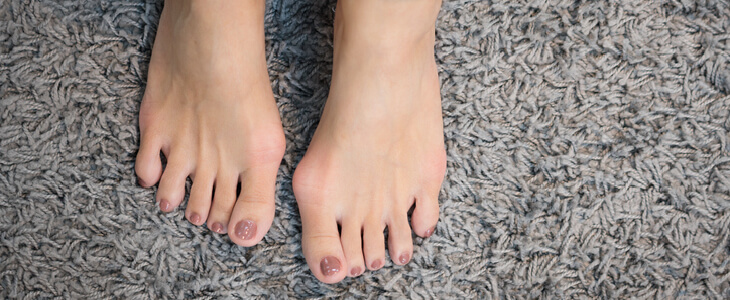If you have undergone bunion surgery in New York only to end up worse off than you were before, contact The Law Firm of Lawrence M. Karam, P.C. Lead attorney Lawrence Karam has 25 years of successful experience fighting for the rights of victims of podiatric malpractice. A failed bunion surgery can result in foot deformity or unrelieved pain.
When you meet with attorney Karam, he will provide you with a free consultation to discuss your legal options. Although winning a podiatry medical malpractice is challenging, Larry has the comprehensive knowledge of the law and the keen litigation skills to recover the maximum compensation you deserve.
Why Bunions Occur and Why They May Require Surgery
A bunion (hallux valgus) is an abnormal bony bump at the joint of the big toe due to a misalignment of the first metatarsal bone that now points toward the other toes, resulting in swelling, redness, and pain. While bunions are not a serious deformity, they can be unattractive and may become more and more painful. Because the bunion is a protrusion, it can prevent the patient from wearing any type of tapered shoe.
Underlying causes of bunions may be a genetic predisposition, abnormal gait, improperly fitted shoes, injury, arthritis, or neuromuscular disease. Once bunion diagnosis is confirmed and an X-ray determines the extent of the problem, surgery may be recommended or requested.
What Bunion Surgery Involves
There are several ways the podiatrist may remove a bunion surgically, some more complex than others, depending on whether a bunionectomy is performed by itself or accompanied by other surgical procedures. The operation may involve several or all of the following:
- Realignment of the ligaments around the big toe joint
- Small cuts to move the bones into a normal position
- Reshaping of the affected joint
- Fusion of the big toe joint
- Fusion of the joint at the mid-foot region (Lapidus procedure)
- Implantation of all or part of an artificial joint, involving fixation devices
As you can see, though not considered major surgery, bunion surgery is a serious business. It may be performed under a local anesthetic, but many patients request general anesthesia because of the trauma involved in cutting bone. Podiatrists may also decide to work with the patient under general anesthesia if the particular bunionectomy is especially complicated. Patients may require from 6 weeks to 6 months to recover and will require a splint or cast, a cane, or crutches until they can put weight on the affected foot.
Lack of Informed Consent
If your doctor did not explain the bunionectomy procedure to you in detail well before the operation, and you have suffered unexpected consequences, you are almost certainly the victim of malpractice. Every patient has the right to know precisely what they are getting into when they agree to surgery. If your podiatrist did not take the time to highlight both the benefits and risks of bunion surgery, your consent was not “informed.”
Why Failed Bunion Surgery Is Not Uncommon
Bunion surgery is technically difficult and although patients typically have elevated expectations of the results in terms of aesthetics and function, such procedures often leave patients not only disappointed but miserable. If you have been through the pain and prolonged incapacity of bunion surgery and feel your podiatrist mishandled your operation, you may have a viable lawsuit.
The most common kinds of failed bunion surgery result in:
- Undercorrection, when the bunion is still apparent after surgery
- Overcorrection, when the big toe is misaligned away from the foot (hallux varus)
- Nonunion or malunion of bones
- Stiffness or immobility of big toe
- Over-shortening of the big toe
- Cock-up toe, in which the toe no longer touches the ground
- New or ongoing pain
Any of these problems may be the result of your podiatrist’s ineptitude or a mistake in calculations relative to surgical cuts. Any of them may make walking difficult. In our experience, the operative reports podiatrists complete after an operation rarely include their errors. We can, however, get around this subterfuge by carefully examining before and after X-rays to make your case.
If your bunion comes back weeks or months after surgery or if your big toe begins to veer away from your foot, an error likely occurred during the procedure. This is the time to call Larry Karam for a free consultation. If yours is a case of podiatry malpractice, Larry will fight to recover damages and won’t charge you any attorneys’ fees until he does.
Services Larry Karam Provides to Patients Whose Bunion Surgery Failed
As a patient who has suffered, and likely continues to suffer, the consequences of a failed bunion surgery, you need time to recover both physically and emotionally. Once you become our client, Larry Karam will take over all legal and logistical matters so you can rest, including:
- Communicating directly with opposing attorneys and insurance adjusters
- Examining all podiatric and other medical reports pertinent to your case
- Investigating your podiatrist’s history for possible evidence of other medical negligence
- Interviewing witnesses
- Consulting with experts in podiatry and other relevant fields (e.g. neurologists, orthopedics) who can provide supportive testimony
Most of all, Larry will create a podiatry malpractice strategy designed to bring you a win at trial, and keep you informed about your case’s progression through the judicial system.
Contact Our Experienced Podiatry Malpractice Attorney Today
Larry Karam is not only an outstanding attorney; he is also an empathic person who has a genuine concern for your best interests. He will do everything in his power to provide you with the damages you need to cover your loss of income, medical costs, and other related expenses, and to compensate you for your pain and suffering, deformity, and/or restricted mobility. Call him now so he can begin working to bring you the resources you need going forward.

